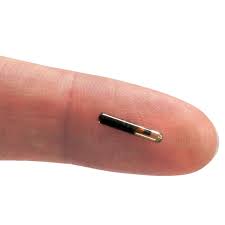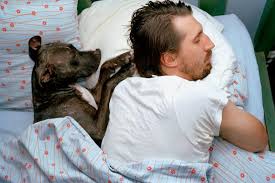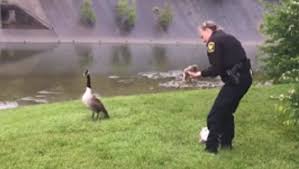An Effective Way To Protect Your Pet From Loss And Theft
Doc Halligan, Lucy Pet Foundation
 Because identification tags on a pet's collar or halter can come off, microchipping is an additional way to ensure that your pet will be returned to you if lost. However, microchips should not be used as a substitute for standard ID tags. A microchip is a tiny computer chip, the size of a rice grain, with an identification number programmed into it. It is not a tracking device.
Because identification tags on a pet's collar or halter can come off, microchipping is an additional way to ensure that your pet will be returned to you if lost. However, microchips should not be used as a substitute for standard ID tags. A microchip is a tiny computer chip, the size of a rice grain, with an identification number programmed into it. It is not a tracking device.
These chips were originally developed to identify livestock. The chip is injected with a hypodermic needle deep under the skin of your pet's neck, usually between the shoulder blades. The injection itself is the same as any regular vaccination and will cause no physical side effects.
A special scanner is used to send a radio signal through the skin of your pet to read the chip. The animal feels nothing as the scanner is passed over him and the chip is read. The microchip number is then relayed to the scanner, where it is displayed. No two microchip numbers will ever be the same, so you can be assured that your pet's microchip number is totally unique.
The chip itself has no power supply to replace or moving parts to wear out, and therefore can be expected to last decades, well beyond the lifespan of your pet. Your pet's number is then registered to the chip company's database, which will trace your pet back to you if found. But if you move your residence, you must contact the chip company, pay a small fee, and give them your new address and contact numbers.
All animal shelters and veterinary clinics have scanners that will read chips. After a scan, the shelter or vet clinic calls in the code to the chip company's database of pets with identifying microchips, and the lost animal's owner will be contacted immediately, providing the owner has a current phone number or address on record.
 Puppies and kittens can be microchipped as early as 8 weeks old. Microchips are suitable for almost any pet, including horses, reptiles, rabbits, birds, exotics, and even fish. It is an injection and while the needle is sharp, most animals don't even react. (I've even had clients ask about chipping people, but to date, it hasn't happened—although you never know!)
Puppies and kittens can be microchipped as early as 8 weeks old. Microchips are suitable for almost any pet, including horses, reptiles, rabbits, birds, exotics, and even fish. It is an injection and while the needle is sharp, most animals don't even react. (I've even had clients ask about chipping people, but to date, it hasn't happened—although you never know!)
A microchip is completely permanent, and can't be cut off or altered. If your pet is ever stolen and sold to a research facility, it will be returned because most research facilities won't take an animal that has a microchip implant. I've seen a small percentage of microchips move or migrate, which can make it more difficult for the scanner to pick up. However, this is rare, and if they do migrate, they don't cause any problems with your pet, but may be missed by the scanner.
Microchips are very affordable. The cost of getting your pet microchipped can range from $25 to $65, depending on where you have the procedure done. If you plan on taking your dog overseas, make sure that you get a universal microchip.
Again, microchips should not replace a collar and identification tag. Collars and tags are the best insurance you can provide to ensure your pet's safe return should it become lost, but even those sometimes fall off. So make sure you pet is microchipped, and has a collar with an identification tag.
 The Mission of The Lucy Pet Foundation is to reduce pet overpopulation by having mobile spay/neuter clinics across the country and to support causes that benefit animal welfare. The Lucy Pet Foundation not only offers free and reduced spays and neuters, they also do microchipping, vaccines and de-wormings. Spaying and neutering is not only great for pet population control, but it has been proven that an animal will live on an average of 40-percent longer after having this surgery.
The Mission of The Lucy Pet Foundation is to reduce pet overpopulation by having mobile spay/neuter clinics across the country and to support causes that benefit animal welfare. The Lucy Pet Foundation not only offers free and reduced spays and neuters, they also do microchipping, vaccines and de-wormings. Spaying and neutering is not only great for pet population control, but it has been proven that an animal will live on an average of 40-percent longer after having this surgery.
Visit Website
 Extreme Heat Tips: Keeping Your Dog Safe When the Temperature Soars - Dr. Debbie
Extreme Heat Tips: Keeping Your Dog Safe When the Temperature Soars - Dr. Debbie
"Oh, but it's a dry heat." We've all heard that comment, used to describe the desert Southwest climate, one which becomes especially taxing on Southwest U.S. residents during the summer months. The desert may lack the added humidity concerns that much of the country knows, but when temperatures escalate above 100 degrees, you can't dismiss the dangers of that infamous dry heat.
As the mercury rises, so too do the number of heat stroke cases veterinarians see. The basic reason why dogs succumb to heat stroke lies with their differing cooling mechanism. Humans sweat to dissipate heat, while dogs pant. When faced with high temperatures, high humidity, exercise or excitement, panting fails miserably at cooling dogs.
Pet owners should be observant for symptoms of heat stroke including excess panting, anxiety and thick ropy drool. As heat stroke progresses, dogs may exhibit vomiting, diarrhea, a dark to blue color of gums and collapse. Shock sets in as high temperatures damage the brain, respiratory system, kidneys, and digestive tract.
Be especially vigilant with at-risk dogs such as senior dogs, those with chronic illnesses and breeds like Pugs, Bulldogs and Boston terriers whose short face and upper airway conformation makes it more difficult cool off in high temperatures.
Here are the top 5 misconceptions about heat stroke in pets:
1. Heat stroke only occurs during peak daylight hours.
FALSE: Extreme temperatures continue to rise into the afternoon and remain a threat to pet even after dark. Dogs left outdoors in evening hours can still develop heat stroke long after the sun has set. For best safety keep pets indoors day and night during extreme heat. Limit exercise to early morning hours before sunrise, since evening temperatures are anticipated to remain high.
 2. Dogs can't get heatstroke if they are left with access to pools or shade.
2. Dogs can't get heatstroke if they are left with access to pools or shade.
FALSE: Outdoor cooling resources like doggie pools, misters, shade and ice blocks may not be enough to prevent a fatal heat stroke event. Access to these cooling means does not guarantee protection. Keep pets indoors during dangerous heat.
3. Heat stroke can be treated at home without veterinary care.
FALSE: Heat stroke is a life threatening emergency which requires appropriate intravenous and emergency veterinary care. Prompt veterinary care is important and delayed home care efforts can jeopardize survival. Plunging a pet into very cold water or ice baths will worsen a pet's odds of surviving heat stroke. Intense cold and ice causes capillaries to constrict, trapping heat in the body core and prolonging dangerous heats effects on the vital organs in the body.
4. Only dogs get heatstroke.
FALSE: Cats are less prone to heat stroke because they aren't as physically active, but elderly or chronically ill cats are less apt to recover from heat's effects. Rabbits and chinchillas are very sensitive to high temperatures, succumbing to heat stroke easily with temperatures just above 80 degrees. Caged pets like rabbits, ferrets, birds and chinchillas suffer heat stroke deaths when left home during family vacation and power outages shuts off air conditioning. Have a pet sitter check on any pets once or twice daily during summer months.
 5. It's okay to leave dogs in cars as long as you open windows wide, not just crack the windows.
5. It's okay to leave dogs in cars as long as you open windows wide, not just crack the windows.
FALSE: Never leave a dog unattended in a car during summer. Even if windows are fully open, the hot vehicle environment with little air circulation becomes a death trap for dogs. Even a few minutes in a hot car can prove dangerous.
Every second counts when a dog is faced with heat stroke. See a veterinarian immediately with any concerns of heat related illness and be especially cautious during the upcoming heat. Look out for your furry friend and keep him safe in the coming heat wave.
Featured veterinarian known as "Dr. Debbie" on national pet radio program, Animal Radio. Ebook author of "Yorkshire Terriers: How to Be Your Dog's Best Friend"; "Pugs: How to Be Your Dog's Best Friend"; "Mini Schnauzers: How to Be Your Dog's Best Friend"; and "Shih Tzu: How to Be Your Dog's Best Friend." Dr. Debbie's books.
Visit Website
No More Dog Hugs, Kisses, Sleeping in Beds or Feeding the Kids Vegetables
Robert Semrow, Animal Radio Listomania
 Studies have concluded that most dogs don't like to be hugged. This comes on the heels of other studies and Internet breaking shockers like you shouldn't kiss your dog or let them kiss you, don't let them sleep in bed with you and also human children don't like to eat their vegetables. OK, the last one was obviously given to me by my young daughters…nice try, go eat some broccoli!
Studies have concluded that most dogs don't like to be hugged. This comes on the heels of other studies and Internet breaking shockers like you shouldn't kiss your dog or let them kiss you, don't let them sleep in bed with you and also human children don't like to eat their vegetables. OK, the last one was obviously given to me by my young daughters…nice try, go eat some broccoli!
This study set the Internet a blaze with something that when I first heard it I went - Duhhhh! Then I said, "Do we really need a researcher to tell us that hugging dogs can make them uncomfortable?" We were all kids and if being uncomfortable was the criteria I have a lot of aunts, uncles and others who needed to know that I didn't feel comfortable or want their hugs, kisses and pats on the head.
I guess for me, this falls in to the area of knowing your pet. You know if your pet wants to be hugged, played with or is stressed. And if you don't, you're probably going to ignore the study anyways. What I also love is that many of the headlines screamed dogs don't want hugs therefore dogs shouldn't be hugged. Well, I've got news for the headline writers, Dr. Internet and others, my dogs love being hugged! In fact, mine line up each morning as the kids are getting ready to go to school to get- brace yourself Dr. Internet - hugs, kisses and belly rubs from my daughters and me.
We don't force them to hug us or accept our hugs. We also don't demand they be there if they aren't feeling up to it. If your dogs don't want something, and it's not harmful to them, I have a hard time thinking of a reason to force them to do something.
 I understand the concerns of the potential lashing out. No one wants that and no one should expect anyone wants a hug from them - human or canine. Still, the overhyped nature of this, and maybe it's just me… acted as if over hugging and being kind toward pets was somehow causing an epidemic that would bring the uniting of dogs and cats to rise up and make us regret loving our four-legged family members.
I understand the concerns of the potential lashing out. No one wants that and no one should expect anyone wants a hug from them - human or canine. Still, the overhyped nature of this, and maybe it's just me… acted as if over hugging and being kind toward pets was somehow causing an epidemic that would bring the uniting of dogs and cats to rise up and make us regret loving our four-legged family members.
Well, I know my dogs and I also know when they want to be left to themselves. I have shown my daughters how to be in tune with their temperaments and the needs of our pets. I watch and observe and give them the physical and emotional space they need, which can vary each day.
Also, it's a great way to know when Zoey, in particular isn't feeling well. She is our bundle of love who wants nothing more than to be in contact with you and near you. She'll kiss you if you ask for a kiss and if you don't give her one she just might stomp her feet to say, and I know I'm no researcher, but I'm certain she's saying Dad, where's my smooch! Don't worry Zoey, I'm not going to pressure you for hugs, kisses or to have you sleep next to me…however, Zoey, you are always welcome to give or receive hugs as you wish.
Know your pets and know their limits and love languages. Share your pet's views on hugs and more on our Animal Radio Facebook Page.
http://petworldinsider.com
Animal Radio News - Lori Brooks
 Xylitol (Found in Many Products) is Deadly to Pets
Xylitol (Found in Many Products) is Deadly to Pets
Here's an alert for all dog lovers that you may already know but is a reminder that xylitol could be deadly if given to your dog. Xylitol gives sugar-free gum and many other products like peanut butter, breath mints, baked goods, chewable vitamins, mouthwash and toothpaste their sweetness, but it is very dangerous to dogs. Xylitol isn't dangerous to people, but dogs absorb it quickly, which can spike their insulin levels, causing dangerously low blood sugar that can be life-threatening if it is not treated right away. Symptoms include: lethargy, weakness, lack of coordination, staggering and seizures, but be aware that symptoms may not appear for as long as 24 hours. And if you have cats, they are not tempted by sweets like dogs are, so xylitol isn't as big of a threat to them seeking it out.
 Shelter Dog Found Home in Shelter
Shelter Dog Found Home in Shelter
Ann had been a shelter dog for more many years, but don't be sad for her. She was in a good place, still in a shelter, but it was a shelter for homeless men where all of guys loved her. For years, Ann, a chocolate Labrador-Rottweiler mix had been the live-in companion of homeless men who temporarily resided in the Pittsburgh area shelter, which was housed in a former church building. You have to love that the homeless shelter rescued Ann when she was 8 years old after her family "surrendered" her because they had a new baby. Her adoption prospects didn't look good as a large senior dog, and prospective adopters just passed right by the gray-faced Ann. When the shelter decided they had had such good response from therapy dogs that had visited, they wanted to do something similar, only they didn't need a therapy dog, they just needed a nice, calm, quiet dog. When they visited the dog shelter, Ann was the only dog in the shelter that wasn't barking - the perfect, nice, calm and quiet dog they needed.
Social Media Helps Scientists
Studying photographs of animals posted online by the general public proved to be as valuable as traditional fieldwork in research on the locations of species that have evolved with different colors. It's called Color Polymorphism - the occurrence of two or more color types in the population of a species. These different color types often vary geographically, providing a useful way of studying how different color morphs evolve in animals. It turns out that social media, where we all love to post photos of pets and see other animals, proved useful when tagged with their location because scientists were able to view photos posted online and learned more about the population of animals in the wild and their differences based on location. It took animal research to a whole new level of cost effectiveness and was faster to do certain types of research that previously had to be done in the field. However, the method can only be used for animals that have many photos online and will work best when species are "conspicuous, fairly common and of interest to photographers." If more photographers geotag their images with location and dates. Their pictures could be even more valuable for ecology.
 Paralyzed Kitten Received Lego Wheelchair
Paralyzed Kitten Received Lego Wheelchair
A kitten that was found paralyzed and abandoned by its mother on the streets of upstate New York was given a unique makeshift wheelchair by a local veterinarian. This mobility device was made out of Legos! The staff at Massapequa Pet Vet staff gave the 5-week-old kitten the name Mac N'Cheez because it was brought to the shelter in a box of macaroni and cheese. See video here.
Pictures of Your Pet Can Lift Your Mood
We all love our pets and whenever anyone felt socially rejected or sad, research from Miami University showed that just a thought, or a picture of their pet, lifted their mood. In the study they also found that just thinking about another human did not produce the same effect. Those who worked on the study actually conducted three separate studies in which participants were asked to re-live past experiences of social rejection and afterward they were then asked to name pictures of animals with their feelings recorded and analyzed. Participants who thought of names for animals reported less negative emotions and feelings of rejection than those who did not. They found people who connected with animals to cope with their own loneliness were actually using an effective emotion-regulation strategy. For example, when college students were asked to re-live the pain of past social rejection, writing about their pet reduced feelings of rejection as effectively as writing about their best friend, both of which alleviated rejection more than drawing a map of their campus. The bottom line? Next time you're feeling socially rejected, look at any picture of an animal and give the animal in the photo a name. You'll feel the connection and feel better.
 Goose Knocked on Police Cruiser for Help
Goose Knocked on Police Cruiser for Help
A mother goose knocked on the door of a Cincinnati police cruiser in her search for help for a gosling tangled in a Mylar balloon string. The officer in the car said he initially thought the goose was hungry when he discovered her pecking at the door of his car. He said the goose kept pecking and pecking. Normally they don't come near people, then it walked away and stopped and looked back with that, "What are you waiting for look!" so the officer followed it and the goose led him directly to the baby that was tangled up in a big wad of string attached to a balloon in a pile of litter in a creek. It was successfully removed and everyone was fine again.
 Listen to the entire Podcast of this show (#1175)
Listen to the entire Podcast of this show (#1175)





